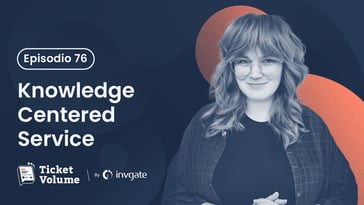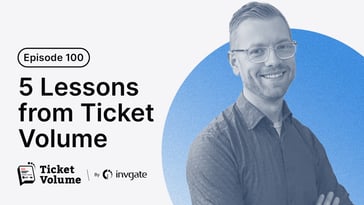The High-velocity IT approach includes both speed and direction. For the sake of experience management, it helps emphasize that doing the right thing is more important than simply doing things quickly. It focuses on how your work environment makes you feel and its connection to the relevance of co-created value between IT service providers and end users.
For guidance, Mark Smalley discussed the insights of this book "High-velocity IT" and its spin-off, "Reflections on High-velocity IT" on the 25th Episode of Ticket Volume, our IT podcast.
He is an accomplished ITIL author, co-author, and a highly experienced IT management consultant and trainer. His expertise has made him a trusted advisor to various organizations, including the DevOps Agile Skills Association and ASL BiSL Foundation. He excels in his field with a strong focus on IT systems and service management.
But this article is just a recap! The whole episode is for all service management professionals looking to enhance their understanding of high-velocity IT and elevate everyone’s experience. Brace yourself for an insightful journey that will challenge your perspective and empower you to excel in the ever-evolving IT landscape.
Don't forget to register for our monthly live recordings and ask your questions directly during the sessions!

Objectives of high-velocity IT are the highlight of his book
High-velocity IT is Smalley’s primary contribution to ITIL 4. Within that, he is most proud of the five objectives related to identifying the weakest link in management. And it is easier to address them when formulated as questions.
- Are you doing the right thing?
- Are you doing it quickly?
- Are the systems resilient?
- Are you as an IT service provider co-creating value with the end users?
- Are you concerned with the assurance, governance, risk, and compliance requirements?
But, out of all, Smalley remarked that the fourth one on co-creating value with service consumers is essential. It is emphasized that value can only be created when the service and products are used effectively.
When he asked them in conferences he was surprised by the fact many organizations focus on survival rather than disruption. Disrupting the marketplace is not a priority for most, but that is why his book explores unconventional ideas.
In this episode, Smalley reflected on the key behavioral patterns he wrote in his book should be better understood as aspirations. Here is a recap of what he means by that:
Psychological safety as an aspiration in the workplace
Smally emphasized key factors that attract people to the workplace:
- Continual improvement and learning
- Ethical behavior and doing the right thing
- Trust and being trusted
This approach, of course, it’s about psychological safety, which is important for attracting people to the workplace. It involves feeling comfortable bringing personal values to work, and at the same time not having fear of negative consequences for expressing difficult points.
The latter encourages critical thinking as it is essential for growth and improvement. IT managers can benefit from presentations, books, and conferences that show new things or existing things from a different perspective.
After attending courses or reading books, it's crucial to apply new knowledge in the workplace. Continual learning and improvement are necessary for making significant changes. But, consider cognitive load and bandwidth limitations when implementing new ideas.
The happiness of the middleman
Yes, happiness. Beran and Smalley both agreed it creates a chain effect on customer satisfaction. Although it’s true some individuals prefer inertia while others embrace change, a happy mindset is a vibrancy at work that contributes to vitality and productivity. Organizations vary in their level of energy for driving change, so you better encourage a positive one if you are an IT leader.
So, by giving managers autonomy to foster trust, fun, and play at work. Since employee experience is crucial for customer satisfaction, middle managers play a vital role in shaping EX.
Of course, managers cannot determine the happiness of their employees, but they can make them miserable. Smalley explained the power of a manager is in creating conditions for happiness rather than directly controlling it.
One way to see this translated is by considering not only service-dominant logic as an alternative to command and control management. It focuses on customer experience, supplier experience, and employee experience. But also, by considering experience-dominant logic, which emphasizes the importance of individual experiences in services, meaning human beings seek emotional well-being and happiness from services.
Bear in mind, that measuring subjective experiences in services can be challenging due to individual differences. Hence, Smalley pointed out that continuous checking of hypotheses is necessary even if the measurement is not entirely successful. He recommended that engaging with customers creates an experience that shows effort and care.
Introduction to the Business Model Canvas
Even though he mentioned the Business Model Canvas briefly in his reflection book, this model created by Alex Osterwalder and colleagues, is a well-known tool for visualizing an organization's activities and it can be used in high-velocity IT. It consists of three main sections: value propositions in the middle, market engagement on the right, and key activities, resources, and partners on the left (referred to as the back end). The back end represents the operating model of the business.
There are key components of the Operating Model by Andrew Cambell and he suggested focusing on six key of them when detailing the activities, resources, and partners:
- P stands for process and value chains (or value streams), representing what activities are performed.
- O stands for organization and people, addressing how the organization is structured and what skills are required.
- L stands for locations and assets, including physical assets like buildings or machinery.
- I stands for information and technology needed in processes and value streams.
- S stands for suppliers and partners, considering who should perform certain tasks or provide specific services.
- N represents management systems that oversee performance and improvement.
According to Smalley, Andrew says it’s as easy as using a whiteboard with sticky notes to create a visualization of how things are done within an organization. This visualization can be a high-level one-pager or a detailed operating model spanning multiple pages. It serves as a tool to identify important aspects of current operations or future plans.
Nonetheless, he remarked it is important not to overwhelm oneself by trying to address every issue at once. So, set limits and prioritize which aspects of the operating model to focus on.
Bottom line
Don't miss out on the full recording of Ticket Volume's episode with Matt Beran as this short recap only covers a fraction of what was discussed. Make it a priority to catch up and gain valuable insights from Mark Smalley about experience management in high-velocity IT!
You can find the full episode on Apple Podcasts, Spotify, YouTube, or your favorite podcast platform. And remember to subscribe if you want to be a part of the monthly live recordings!















